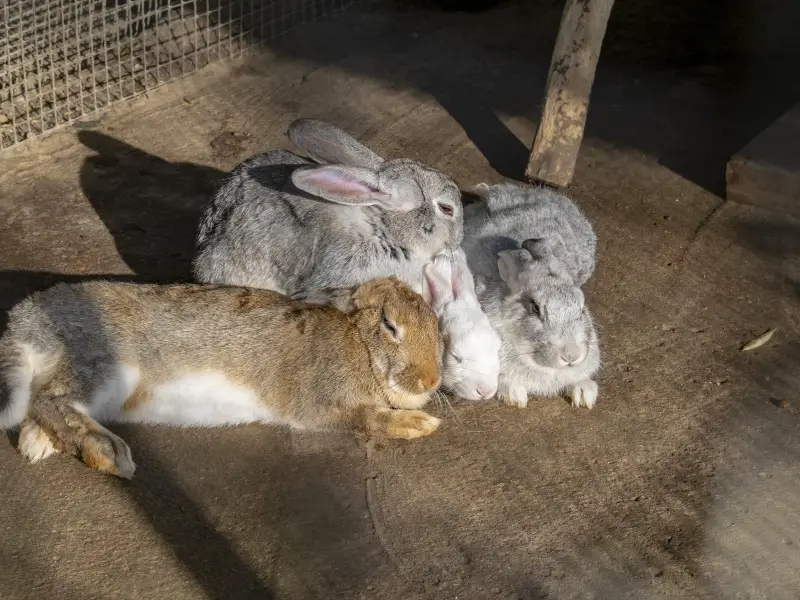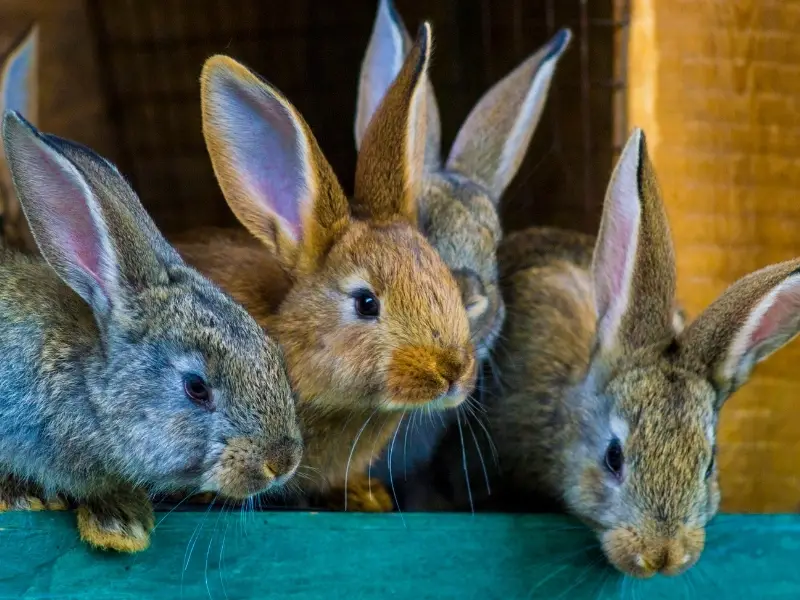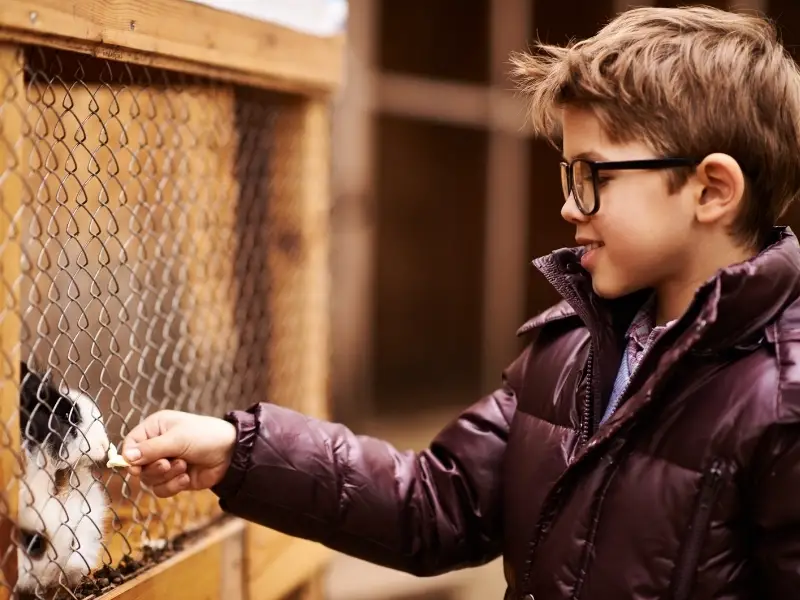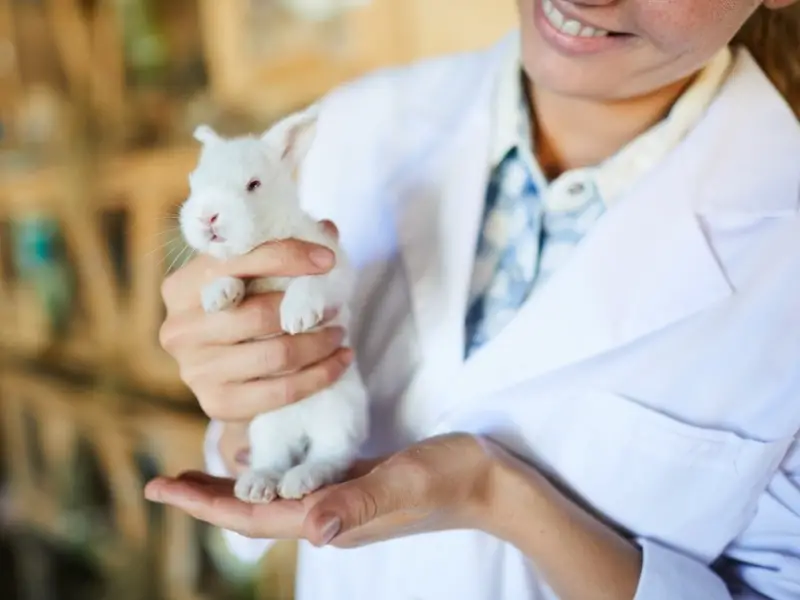If you’ve heard the phrase “breed like rabbits” you’re probably wondering if there is any way to monetize the fact that rabbits multiply like crazy. If you like animals or have owned rabbits before, now is the perfect time to start a rabbitry and breed rabbits at home.
How to start breeding rabbits? First of all, you will need to choose the breed of rabbit you want to keep. Decide whether you want to breed rabbits as pets, raise them for meat, or sell them for profit. After you find the right breed you’ll need to wait until your rabbits are at least six months old to breed them.
If you are interested in raising rabbits, you are in the right place! In this article, we’ll tell you everything you need to know about breeding rabbits and how to make a profit.
Why Breed Rabbits?
There are several reasons why raising rabbits at home might be a good idea. You may already have a motive for starting a rabbitry but if you don’t, here are some reasons:
For Pets
If you already own two great pet rabbits you might be interested in breeding them to create more adorable pets.
You may have noticed how docile your bunnies are, or how friendly and calm they are with your kids. Maybe, your friends and neighbors are stopping by your home frequently only to spend time and pet your cuddly rabbits.
Whatever may be the case, breeding rabbits is a great way to create more pet rabbits.
There’s one thing you should keep in mind if you want to breed rabbits as pets. Rabbits are extremely prolific breeders! Thus, if you are only looking to breed a single litter of rabbits, you will need to keep the original buck and doe separated, or consider spaying or neutering one of them.
Furthermore, ensure that the rabbits you are breeding aren’t siblings. Inbreeding should be avoided at all costs since it can cause serious genetic mutations.
For Income
If you love rabbits and have the necessary conditions to keep them, breeding and selling rabbits can be a great way to earn some extra money. While raising rabbits does come with some upfront costs, you can turn a profit in a relatively short time.
Depending on the breed and the lineage you can earn between $20 and $200 per baby rabbit. If you plan to breed rabbits to sell them make sure to mate rabbits of the same breed. While there is a good market for purebred rabbits, mixed-breeds have little to no value.
If you plan to sell rabbits, make sure to have enough space, time, and money to care for them properly.
Although it can make a decent profit, breeding rabbits is a big responsibility that takes time and patience. So, before you start be sure that this is something you truly want and can commit to doing.
Don’t forget, rabbits are living creatures that require care and attention to stay happy and healthy.
So before you set up shop ask yourself: “can I care for the entire litter should they don’t find the right homes?” If the answer is no, you shouldn’t start a rabbit enterprise in the first place.
You should also research the supply and demand for rabbits in your area. Are there people who are interested in keeping rabbits where you live? Or are there any other businesses that sell rabbits close by?
Do all due diligence before starting your rabbitry, as you would before any other business undertaking.
For Meat
Although rabbit meat isn’t as popular in the United States as it is in other countries, raising rabbits for meat can be a very lucrative business.
If you have the time and space to raise rabbits for meat, this can be a quite simple production that can turn a nice profit. In fact, this can be an especially profitable endeavor if you plan to raise your rabbits on grass and market them as grass-fed as opposed to raised in hutches.
Once your rabbit meat is processed per regulations, you can sell it to your friends and family, farmer’s markets, high-end restaurants, grocery stores, or dog owners who feed their dog’s raw food (source).
How to Breed Rabbits?

Now that you have a good reason for starting a rabbitry you should learn how to mate rabbits.
Listed below is everything you need to know for successful breeding. Let’s dig in!
1. Choose Two Rabbits
To start your breeding program, you will need a male and a female rabbit. When choosing your breeding pair, never breed full siblings! Inbreeding can result in genetic mutations and should be avoided at all costs unless you have a lot of knowledge about genetics.
While it sounds unnatural you can breed half-siblings. Meaning you can mate a mother rabbit with her son, or a father rabbit with his daughter. Breeding cousins are also acceptable and shouldn’t cause genetic mutations.
2. Only Breed Healthy & Happy Rabbits
While it might seem obvious, the physical condition and the health of your rabbits are very important for breeding. If one of your rabbits shows signs of illness or is aggressive, you shouldn’t breed them. A sick rabbit might carry a genetic condition that can be passed to its offspring.
To be on the safe side, always take your rabbits to be checked by a vet before breeding them. This way you’ll know for sure if your rabbits are in tip-top conditions and ready to mate.
Check your rabbits for signs of diseases or infection, including diarrhea, loose stool, scabs, sores, or discharge. All of these issues need to be treated before you attempt to breed the rabbits.
Focus on breeding only healthy and happy rabbits with the best chance of survival and passing the good genes onto their offspring.
3. Mate Rabbits of the Same Breed
If you are planning to sell rabbits, know that people want only purebred rabbits. Mixed-breed rabbits have little value and mixing two breeds also lessens the quality of the stock.
Instead of breeding any two rabbits you can find, take your time to pick two rabbits of the same breed. This will increase your chances of success and help you find buyers for the entire litter.
4. Breed for Specific Traits
Like cats and dogs, purebred rabbits are bred for specific traits. If you have a rabbit with a gorgeous fluffy pelt, you’d want to pass that trait to other generations.
This is just a simple example, but you get the gist. The more selective you are about which traits you want to pass down the more likely it is going to happen with selective breeding.
When to Breed Rabbits?
Once you have the two rabbits that will serve as breeding stock, it’s time to decide when to mate them. As you know, rabbits are prolific breeders, but they don’t actually mate at all hours of the day, every single day in the year.
Like all other species, rabbits need to become sexually mature to breed and produce offspring.
Interestingly, unlike other species, an interesting thing about female rabbits is that they don’t go into heat. So while other animals, like cats and dogs, need to be in heat to be receptive to males, female rabbits are ready to mate at any given time.
As long as your rabbits are old enough to mate, you can breed them at any time of the year.
What Age Can a Rabbit Begin Breeding?
Although rabbits become sexually mature early, you should wait until they are old enough to breed. Keep in mind that small breeds mature faster and can be bred earlier than larger breeds of rabbits.
Male
Depending on the size, male rabbits become fertile when they are between eight and 12 weeks old. However, bucks shouldn’t be allowed to breed until they reach adulthood and are fully mature.
A small breed rabbit male is usually fully mature around six months of age and ready for breeding. Medium-sized bucks are ready around seven months. Giant breeds, on the other hand, need more time to grow so you should wait until they are nine months old to breed them.
To prevent premature breeding you should separate any rabbits when they are four weeks old and start keeping males and females in separate hutches.
If you decide that one of your male rabbits isn’t fit for breeding, you’ll want to neuter them. This is best done once the testicles have descended or at any point after 12 weeks of age.
Female
Although female rabbits can become pregnant when they are 12 weeks old, you should wait until your doe reaches maturity. Small and medium-sized breeds are usually ready at six or seven months of age.
For larger breeds, it’s a good idea to wait until your rabbit is fully grown, and start breeding only after they are eight or nine months old.
Breeding rabbits that are too young can lead to health problems, birthing difficulties, or stillborn kits. Thus, wait until both the male and female rabbits are old enough before attempting to mate them.
Breeding Process

When your rabbits reach maturity, it’s the perfect time to start breeding them. While the actual act doesn’t last long, you should understand what is happening and what to expect, to know if the breeding was successful.
Without further due, here’s what the breeding process should look like:
Take the Doe to the Buck
When it comes to mating, choosing the right location is especially important for rabbits. Always take the female rabbit to the buck’s cage!
A doe’s cage will smell like her, making the buck distracted and eager to mark new territory. Furthermore, female rabbits are territorial and might become aggressive and fight with male rabbits over territory.
To avoid all of these issues, it’s always better to bring the female rabbit over in the male rabbit’s cage and allow the breeding to happen there.
Leave the Pair Together
A fully mature rabbit can breed any day of the year, so don’t be surprised if your rabbits go at it almost instantly.
Sometimes, the two rabbits will run around in circles or play a little before the female lifts up her tail indicating that she is ready. At this point, the buck will come behind and mount her.
The actual act is over quickly, so you’ll want to observe closely to ensure that the breeding actually took place.
You can tell that the mating happened if the male grunts and falls off the female rabbit. If you never bred rabbits before, this might seem strange, but there’s nothing to worry about – both the buck and the doe are perfectly fine.
However, if there’s no grunting or falling off know that the breeding wasn’t successful.
To increase the odds of conception some breeders let their rabbits mate three times in a session. On the other hand, some wait 30 minutes or one hour to breed their rabbits again to ensure successful mating.
Giving your rabbits a chance to breed for a second or third time in a row increases the chance of pregnancy and can also help with the litter size.
Separate the Rabbits
Regardless of their endless desire to breed, not all rabbits are successful the first time. Some rabbits may fight while others decide to run around and play.
If your rabbits don’t show interest in breeding after 30 minutes, remove the doe and place her back in her cage. Ideally, you should wait at least 12 hours before attempting to breed your rabbits again.
Also, if the doe seems anxious, aggressive, or is trying to run away from the buck, separate them immediately and take the female rabbit back to her cage.
Signs of Rabbit Pregnancy
After successful breeding, the biggest question is whether the doe is pregnant or not. While there are no outward signs of pregnancy, there are a few things you can do to determine if your rabbit is indeed pregnant.
Two weeks after a successful mating you can examine your doe by feeling her abdomen. Using your fingers gently palpate the doe’s stomach to see if there are any babies inside. If the rabbit is pregnant you’ll be able to feel grape-sized embryos.
Another thing you can do is to weigh your rabbit before mating, and then measure her again 14 days after breeding. There’s a big chance that your doe is pregnant if she weighs more the second time.
While these two methods can be helpful, they are by no means 100% accurate! If you want to know for sure whether your doe is pregnant or not, take her to the vet for an ultrasound.
Rabbit Gestation Period
A rabbit’s gestation period typically lasts between 31 and 33 days. During this time, the doe shouldn’t be handled often and her nest box shouldn’t be touched either.
A month is a short time to get everything ready so mark the day of the breeding to know when your rabbit will go into labor. Also, if your rabbit doesn’t go into labor after 33 days, something can be wrong with the litter or you might be dealing with a false pregnancy.
If nothing has happened after 33 days, take your rabbit to the vet for an ultrasound. Depending on what is going on, your vet might try to induce your rabbit to avoid complications.
Delivery
Expect the doe to give birth 28 to 33 days after mating. Make sure that the mother is properly cared for during pregnancy and that she has enough space to give birth in.
Most do start nesting between 25 and 27 days of the pregnancy. At this time, your doe will begin to pull fur from her body to insulate her nest box.
Some females start pulling fur two weeks before they kindle, so this can be a great way to tell if your doe is in fact pregnant. With that being said, don’t worry if your rabbit isn’t nesting. Some females start building their nest boxes shortly before they kindle.
Keep in mind that nesting and pulling out fur can also happen with a false pregnancy. This deceptive behavior is usually due to a miscarriage.
If you catch your doe giving birth, leave her to it, and don’t be too nosey. Although chances are that the delivery will be over long before you wake up since kits tend to be born before dawn.
After the kits are born make sure that the doe has enough food and clean water and keep an eye on the litter from afar. The doe will clean herself and the nest before starting to nurse her kits.
How Many Bunnies Does a Rabbit Have?
A female rabbit can have between one and 14 kits per litter. However, the average litter size is six.
Sometimes a doe can give birth to a, particularly large litter. If this happens there is a big chance that not all babies will survive due to the inability to reach the mom’s teat.
Newborn Rabbit Care

Once baby rabbits have been born, they need to spend as much time with their mother to nurse and develop properly. The doe is more than capable of taking care of the kits on her own, and you should let nature run its course.
The doe will feed her babies when necessary, cover them with fur to keep them warm and make sure that all their basic needs are met.
That leaves you to ensure that the doe has plenty of fresh food and water and to keep the cage clean. Poor living conditions can cause kits to get sick and die, therefore make sure that the nesting box isn’t covered in urine and feces.
How to Make Money Breeding Rabbits?
Once your very first rabbit litter has been born, it’s time to start thinking about reaping the fruits of your labor. Soon enough the kits will be weaned from their mother and ready to be sold and sent to their new homes.
What Breeds Are Best for Selling
Breeding and selling rabbits is all about supply and demand. At this time, cute-looking, friendly, and easily domesticated rabbit breeds are very sought after. The most popular rabbit breeds are:
- Holland Lop rabbit
- Lionhead rabbit
- Mini Lop rabbit
- French Lop rabbit
- Californian rabbit
- American rabbit
How Much to Sell Rabbits for?
With so many factors at play and a variety of different rabbit breeds, it’s hard to pinpoint an exact price. Generally speaking, you can expect to sell your rabbits anywhere from $20 to $200.
Rarer breeds come with a higher demand which translates into a higher price and better profit. To get a clear picture of how much you can earn by breeding rabbits remember to factor in that you’ll be selling an entire litter. So, the more kits you have in the litter, the higher your profits will be.
Where to Sell Rabbits?
Finding prospective buyers and selling your rabbits might be the hardest part of the entire breeding rabbits enterprise. However, use technology in your favor and try to sell your rabbits online.
Look for homesteading, livestock, and pet groups to advertise your bunnies, and also check the local Craigslist. You should also see if your local pet store is willing to sell your rabbits for a percentage, or at least allow you to advertise in the store.
What You Need to Breed Rabbits
Before you get into the rabbit breeding business ask yourself whether you have the time and energy required to breed and raise rabbits. If the answer is yes and you are committed to setting up a rabbitry, here’s what you’ll need for success:
Food
Rabbits, like all other living beings, need food to survive and thrive. Don’t forget that the doe will need more food than buck while she is pregnant and nursing her litter.
Shelter
Rabbits can be kept both indoors and outdoors, but when you are raising rabbits for profit it’s best to keep them in a shed or unused garage (source). Make sure that the area is filled with natural light and properly ventilated for the winter months.
During warmer months, you can keep your rabbits outside in spacious hutches, or opt to keep them indoors all year long.
Besides a cage or a hutch, you’ll also need to set up a nest box that your doe will use for kindling. Depending on the type, some nesting boxes can be disinfected and then reused when your doe is pregnant again.
Conclusion
Breeding rabbits can be an extremely rewarding experience and a good way to increase your income. While you won’t earn millions raising rabbits overnight, setting up a rabbitry can turn a nice profit.
To increase your odds of success, try to line up potential buyers before breeding your rabbits and spend some time researching local supply and demand. With careful planning and some work, you’ll be raising and selling rabbits in no time!
Related Articles:

